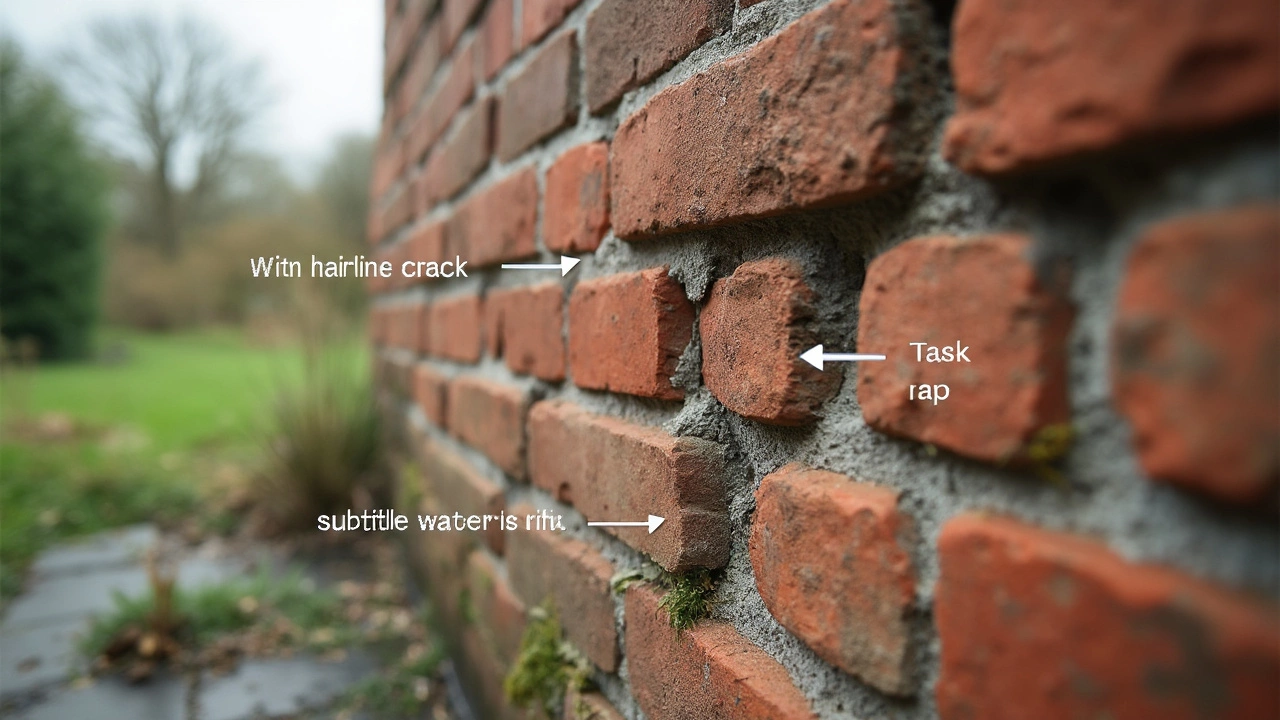Noticed a crack running through your basement wall? Trust me, you’re not alone—it’s one of the most common things homeowners freak out about. The big questions: Does this mean your house is falling apart? Do you need to fix it? And which crack repair options actually work?
Let’s get this straight: not all cracks mean disaster. Some are just signs your home is settling after being built. Others can point to bigger issues, like water sneaking in or even foundation movement. The best fix totally depends on the type of crack you’ve got and why it happened in the first place.
If you try just slapping on some paint (I’ve been there—Boden thought it was a good idea too), you’ll probably see that crack come back. Some cheap fixes look nice for a few months but don’t hold up once the next heavy rain hits. That’s why you need to match the repair method to the actual problem, not just the look of the crack.
- Common Types of Foundation Cracks
- Popular Repair Methods Explained
- Choosing the Right Repair for Your Home
- DIY or Call a Pro?
- Long-Term Tips to Prevent More Cracks
Common Types of Foundation Cracks
If you spot a crack in your basement or crawlspace, figuring out what kind you're dealing with is the first step. Not all cracks are created equal—some are harmless, others need quick action. Here’s what you’re most likely to see:
- Vertical Cracks: These run straight up and down and are the most common. You’ll find them in poured concrete foundations. They usually show up as your house settles. Most vertical cracks are less scary and can often be fixed pretty easily, unless water leaks through.
- Horizontal Cracks: These go side-to-side across your wall. If you see one, pay attention. Horizontal cracks often mean outside water or soil pressure is pushing in, and that’s bad news. If left alone, the wall could start to bow or even collapse.
- Diagonal Cracks: These run at an angle, usually from a corner of a window or door down to the floor. They’re often caused by uneven settling (like when one corner of your house sinks faster than the others). Some start small and grow over time.
- Stair-Step Cracks: Usually show up in brick or concrete block walls, following the mortar joints like steps. They usually mean shifting or settlement in the soil under your home.
Here's a quick look at the most common crack types and what they might mean for your home:
| Crack Type | How it Looks | Likely Cause | Should I Worry? |
|---|---|---|---|
| Vertical | Straight up/down | Normal settling | Low (unless leaking) |
| Horizontal | Side-to-side | Soil or water pressure | High (needs attention) |
| Diagonal | Angled | Uneven settling | Medium (watch for changes) |
| Stair-Step | Step-like in blocks | Foundation or soil movement | Medium to High |
If a crack is wider than a quarter inch, keeps getting bigger, or you see water coming in, don’t ignore it. It’s almost always cheaper to tackle foundation crack repair early, before stuff gets worse.
Popular Repair Methods Explained
So, you’ve got a cracked foundation and you want to know what actually fixes it instead of just covering up the problem. Let’s break down the most common repair methods you’ll hear about—no nonsense, just useful info.
- Epoxy Injection: Got a narrow crack? Epoxy is like superglue for concrete. It works best if the crack is purely cosmetic or keeps your basement dry. Injecting epoxy basically bonds the concrete back together, making it as sturdy as the original slab. The downside? If your crack is from serious shifting or water keeps coming in, epoxy alone won’t cut it.
- Polyurethane Foam Injection: This stuff is great for leaky cracks. The foam expands after injection, filling up all the nooks and blocking out water. It doesn’t exactly “weld” the concrete back together, but it’s flexible enough to handle a bit of movement if the crack grows. Most contractors use this for damp basements or those hairline cracks that drip after a storm.
- Surface Sealants: These are those DIY kits you find at home stores—usually just a paste you slap on over the crack. They work as a quick cosmetic patch, but don’t expect any real structural strength. If water isn’t getting in and you’re selling the house, this might do. Otherwise, keep scrolling.
- Carbon Fiber Straps: These are like seatbelts for your wall. If a horizontal crack’s making your basement wall bow inward, carbon fiber strips can hold everything in place. Not cheap, but way less invasive than rebuilding the whole wall.
- Structural Piering or Underpinning: If cracks are everywhere and doors are sticking, your house may be sinking. This fix isn’t for the faint of heart (or wallet). Contractors drive steel piers deep below your foundation to lift things back into position. Works when the soil under your home has totally shifted, but expect to spend big.
Here’s a quick snapshot of how these methods stack up:
| Repair Method | Best For | DIY? | Average Cost (2025) |
|---|---|---|---|
| Epoxy Injection | Thin, dry cracks | No | $400‒$800/crack |
| Polyurethane Foam | Leaky cracks | Sometimes | $350‒$900/crack |
| Surface Sealants | Cosmetic-only repairs | Yes | $50–$200/crack |
| Carbon Fiber Straps | Bowing walls | No | $350–$600/strap |
| Structural Piering | Major settlement | No | $1,500–$3,000/pier |
Don’t just pick the first fix you see on YouTube. Match the method to your problem, or you’ll just see that crack come back in a year or two—and maybe with friends.

Choosing the Right Repair for Your Home
There’s a world of difference between a skinny hairline crack from a house settling and a fat one with water oozing out after every storm. The wrong repair for the wrong type of crack is just money down the drain. Here’s how to narrow it down so you don’t get burned.
Start with these questions:
- Is the crack wider than a quarter inch?
- Does it go all the way through the wall or just skim the surface?
- Is water coming in?
- Are there signs the crack is getting bigger (like doors sticking or gaps growing)?
If you answered yes to water problems or growing cracks, don’t ignore it. Small cracks can be fixed with basic sealers, like flexible polyurethane. But if water shows up or the crack keeps moving, it’s usually time for a stronger solution—like foundation crack repair with epoxy injection or even exterior waterproofing.
Here’s a cheat sheet that covers common fixes and when to use them:
| Crack Situation | Best Repair Option | Average Cost (USD) | Typical Lifespan |
|---|---|---|---|
| Hairline (no water) | Flexible polyurethane caulk | $70-$200 | 5-10 years |
| Wider (no water) | Epoxy injection | $300-$800 | 20+ years |
| Crack leaks water | Polyurethane foam injection | $400-$1,000 | 10-20 years |
| Vertical moving crack | Repairs plus structural reinforcement | $1,000-$5,000 | Permanent (if fixed right) |
A tip from my own wallet—get a quote from at least two reputable contractors before you commit. The lowest price isn’t always the best fix, especially with something this important. If someone says you need a brand-new foundation for a hairline crack, run the other way.
And don’t forget: sometimes what looks like a foundation problem is just bad drainage outside your house. If your gutters dump water near the wall, you could keep fixing cracks forever unless you redirect that water. Before fixing the crack, check the basics—downspouts, grading, and any low spots where water pools near your foundation.
DIY or Call a Pro?
This is the part every homeowner really wants to know: can you fix that crack yourself, or do you need to bring in the cavalry? There’s a big difference between sealing a tiny hairline crack and dealing with a foundation that’s literally shifting.
If we’re talking about cracks less than 1/8 inch wide and totally dry, DIY might be the way to go. You can grab a concrete crack filler tube at the hardware store for under $20. It’s a quick job—just clean out the crack, squirt in the filler, and smooth it over. Perfect for tiny, non-structural cracks that aren’t growing or letting in water.
But when are you officially out of DIY territory? If your crack is wider than 1/4 inch, running at a steep angle, leaking water, or you see more cracks popping up fast, it’s time to call a pro. Same thing if you notice doors or windows are sticking. That could mean your foundation is actually moving. No caulk from Home Depot is going to solve that.
Typical pros use foundation crack repair materials like epoxy injection or polyurethane foam. These options bond the crack from inside out—way stronger than surface fillers. Here’s how they stack up:
| Method | DIY Possible? | Best For | Typical Cost |
|---|---|---|---|
| Surface Crack Filler | Yes | Tiny, dry cracks | Under $50 per crack |
| Epoxy Injection | No (Pro Only) | Active or structural cracks | $400 - $800 per crack |
| Polyurethane Foam | No (Pro Only) | Leaking or wide cracks | $500 - $900 per crack |
Here’s a simple checklist for when to fix it yourself versus picking up the phone:
- Crack is thin (less than 1/8 inch), dry, and not growing? Try DIY.
- Crack is leaking, wide, or there’s a cluster of cracks? Call a pro.
- You see bowing walls, doors that stick, or uneven floors? Always call a pro.
- Not sure? Snap a photo, measure the crack, and check it every month. Growth means you need help.
One last tip: Good contractors usually offer free estimates, so you’re not risking anything by getting an expert opinion. Better safe than sorry—especially when it’s the bones of your house at stake.

Long-Term Tips to Prevent More Cracks
Once you’ve fixed a foundation crack, you want that fix to stick. Reality check: the best way to keep cracks from popping up again is to control what’s happening around your foundation. Most cracks don’t just show up out of nowhere—water, shifting soil, and missed home maintenance are usually to blame.
Here’s a game plan that actually works:
- Keep water away from your home’s foundation by making sure gutters aren’t dumping water near the base. Add downspout extensions if the runoff isn’t landing at least 5 feet away from the house.
- Grade the soil so it slopes away from your house. Just a few extra inches can push thousands of gallons away during a heavy storm.
- Check for clogged or broken gutters every spring and fall. Water pooling right at your foundation is a fast track to new cracks.
- Fix leaks in outdoor faucets and sprinkler systems right away. Even slow drips can wash out soil and stress your foundation over time.
- If you notice a lot of settling, talk to a pro about better drainage solutions—like French drains or sump pumps—for especially soggy yards.
The type of soil under your house makes a big difference, too. Clay-heavy soil in places like the Midwest or the South sucks up water, swells up, then shrinks hard during dry spells. That constant cycle is a major cause of cracks. If your area has these conditions, consider planting shrubs or grass around your home’s edge—they suck up extra water and help stop soil from shifting so much.
Foundation issues usually start small, so don’t ignore little warning signs. Sticking doors, new cracks above window frames, or weird dips in your floors? Those are red flags. Schedule a checkup with a contractor instead of waiting for a major repair. Small fixes are cheaper—and stress-free—compared to full-blown problems later.
| Risk Factor | Prevention Tip |
|---|---|
| Poor drainage/standing water | Add downspout extensions, regrade soil |
| Clay soil swelling/shrinking | Plant landscaping, maintain even moisture |
| Leaking outdoor faucets | Fix leaks fast, check pipes every season |
| Clogged gutters | Clean gutters twice a year |
| Tree roots growing too close | Keep large trees at least 15 feet from foundation |
If you keep up with these simple habits, you’ll spend a lot less time stressing over foundation crack repair and more time enjoying your house—even if your kids still leave their shoes everywhere.
